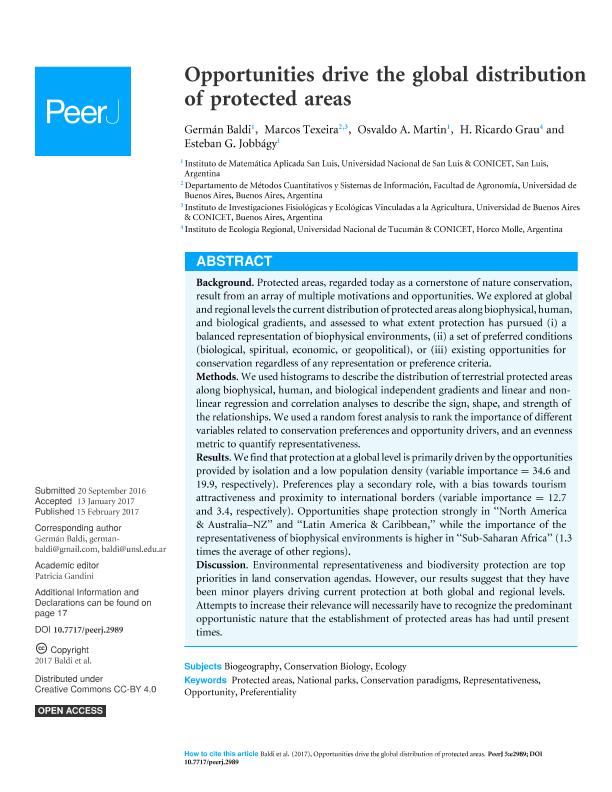Artículo
Opportunities drive the global distribution of protected areas
Baldi, Germán ; Texeira González, Marcos Alexis
; Texeira González, Marcos Alexis ; Martín, Osvaldo Antonio
; Martín, Osvaldo Antonio ; Grau, Hector Ricardo
; Grau, Hector Ricardo ; Jobbagy Gampel, Esteban Gabriel
; Jobbagy Gampel, Esteban Gabriel
 ; Texeira González, Marcos Alexis
; Texeira González, Marcos Alexis ; Martín, Osvaldo Antonio
; Martín, Osvaldo Antonio ; Grau, Hector Ricardo
; Grau, Hector Ricardo ; Jobbagy Gampel, Esteban Gabriel
; Jobbagy Gampel, Esteban Gabriel
Fecha de publicación:
15/02/2017
Editorial:
PeerJ Inc
Revista:
PeerJ
ISSN:
2167-8359
Idioma:
Inglés
Tipo de recurso:
Artículo publicado
Clasificación temática:
Resumen
Background. Protected areas, regarded today as a cornerstone of nature conservation, result from an array of multiple motivations and opportunities. We explored at global and regional levels the current distribution of protected areas along biophysical, human, and biological gradients, and assessed to what extent protection has pursued (i) a balanced representation of biophysical environments, (ii) a set of preferred conditions (biological, spiritual, economic, or geopolitical), or (iii) existing opportunities for conservation regardless of any representation or preference criteria. Methods. We used histograms to describe the distribution of terrestrial protected areas along biophysical, human, and biological independent gradients and linear and nonlinear regression and correlation analyses to describe the sign, shape, and strength of the relationships. We used a random forest analysis to rank the importance of different variables related to conservation preferences and opportunity drivers, and an evenness metric to quantify representativeness. Results. Wefind that protection at a global level is primarily driven by the opportunities provided by isolation and a low population density (variable importance D 34.6 and 19.9, respectively). Preferences play a secondary role, with a bias towards tourism attractiveness and proximity to international borders (variable importance D 12.7 and 3.4, respectively). Opportunities shape protection strongly in "North America & Australia-NZ" and "Latin America & Caribbean," while the importance of the representativeness of biophysical environments is higher in "Sub-Saharan Africa" (1.3 times the average of other regions). Discussion. Environmental representativeness and biodiversity protection are top priorities in land conservation agendas. However, our results suggest that they have been minor players driving current protection at both global and regional levels. Attempts to increase their relevance will necessarily have to recognize the predominant opportunistic nature that the establishment of protected areas has had until present times.
Archivos asociados
Licencia
Identificadores
Colecciones
Articulos(IER)
Articulos de INSTITUTO DE ECOLOGIA REGIONAL
Articulos de INSTITUTO DE ECOLOGIA REGIONAL
Articulos(IFEVA)
Articulos de INST.D/INV.FISIOLOGICAS Y ECO.VINCULADAS A L/AGRIC
Articulos de INST.D/INV.FISIOLOGICAS Y ECO.VINCULADAS A L/AGRIC
Articulos(IMASL)
Articulos de INST. DE MATEMATICA APLICADA DE SAN LUIS
Articulos de INST. DE MATEMATICA APLICADA DE SAN LUIS
Citación
Baldi, Germán; Texeira González, Marcos Alexis; Martín, Osvaldo Antonio; Grau, Hector Ricardo; Jobbagy Gampel, Esteban Gabriel; Opportunities drive the global distribution of protected areas; PeerJ Inc; PeerJ; 2017; 2; 15-2-2017; 1-24
Compartir
Altmétricas



